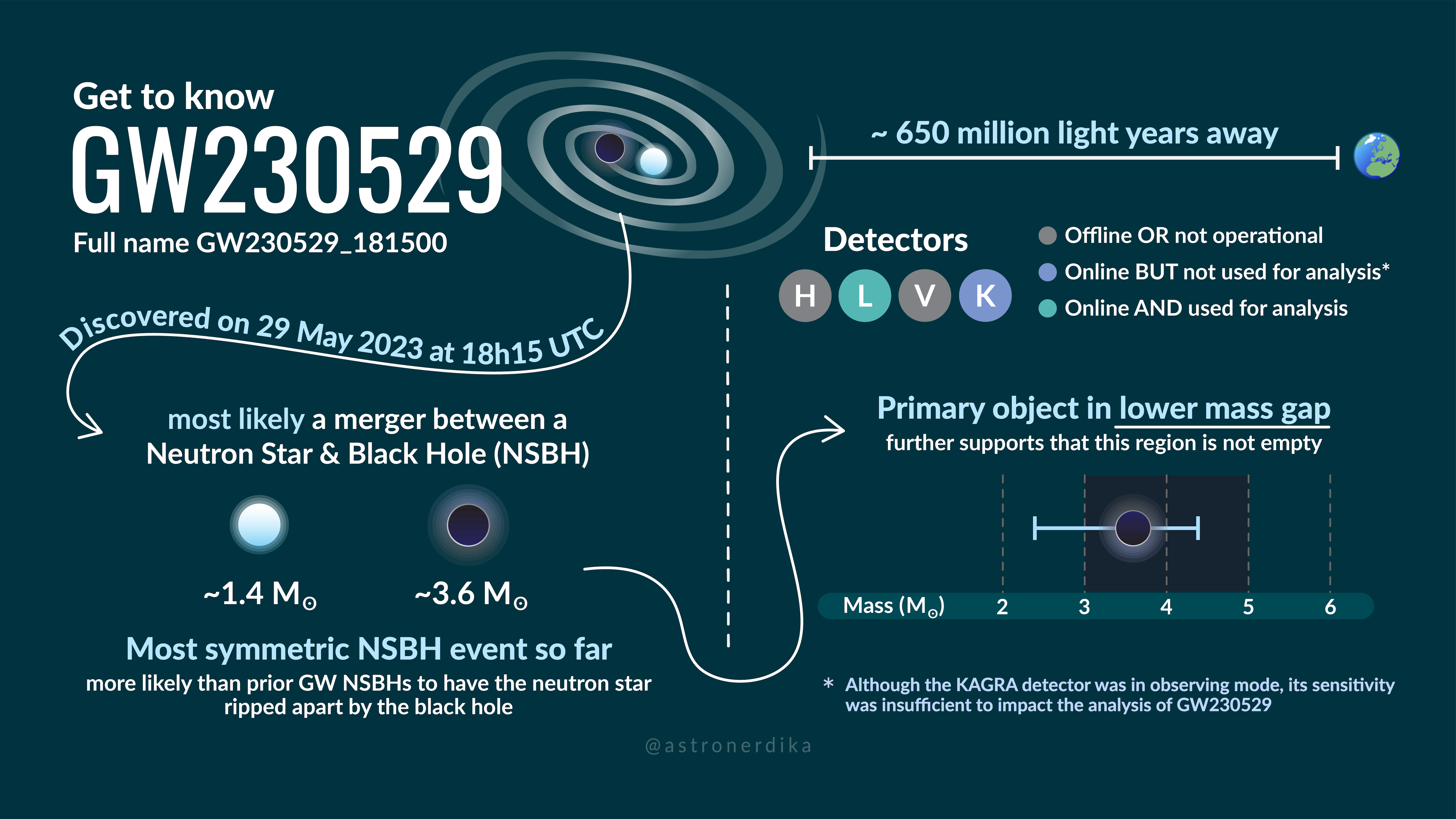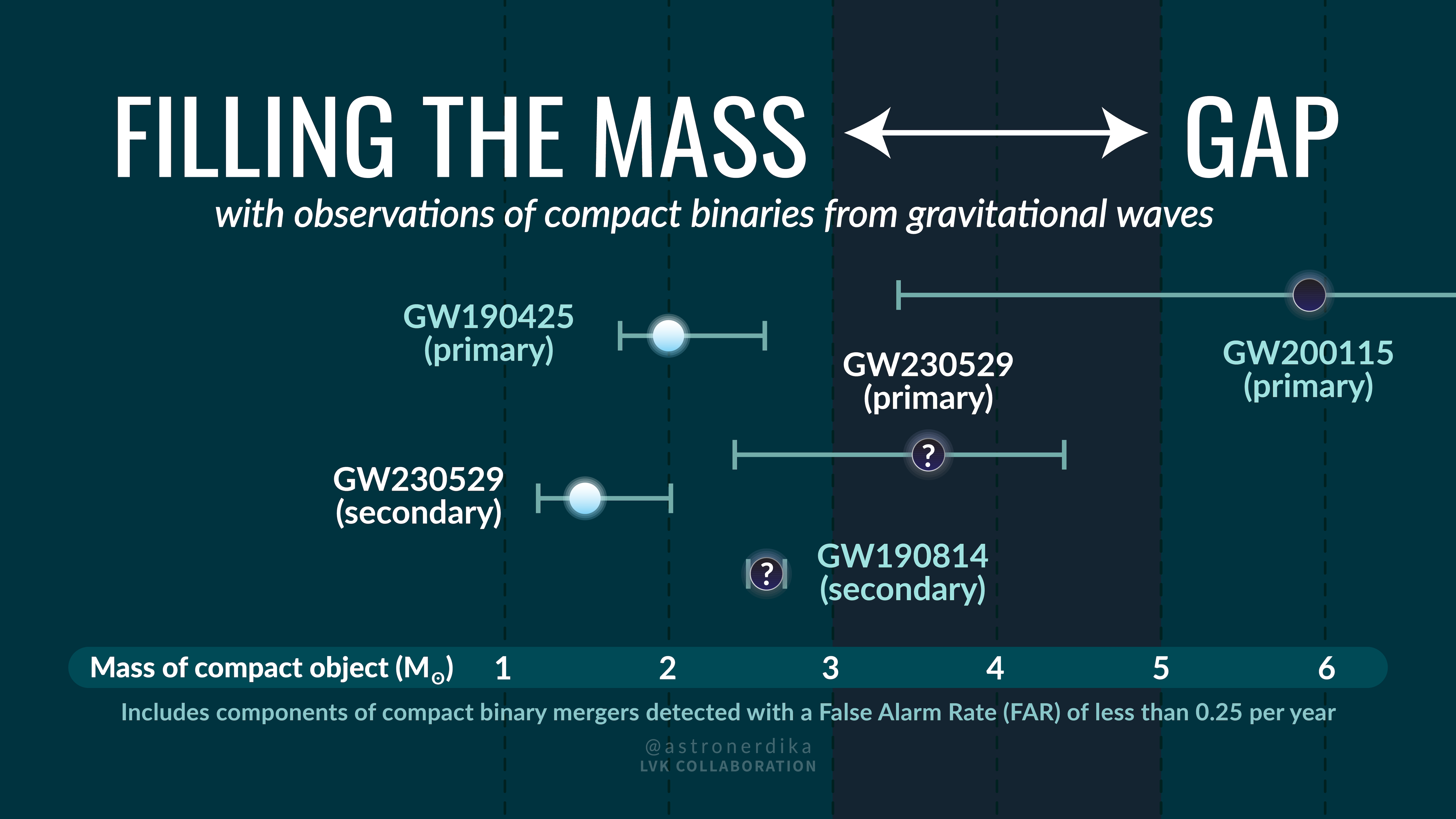
Image: Shanika Galaudage
The LIGO-Virgo-KAGRA international network of Gravitational Wave observatories announced the discovery of an exceptional astronomical event. The event is named GW230529, as it was detected during the first week of the current observing run on May 29 2023 by the LIGO Livingston Observatory in the U.S. The signal resulted from the collision between a neutron star and another compact object of undetermined nature, which lies in the "mass-gap" between the heaviest known neutron stars and the lightest black holes.
GW230529 detection paper is available here
The first direct detection of gravitational waves (GWs) in 2015, with GW150914, marked the dawn of a new era for astronomy. Since then, many more GW detections have been made, originating from different types of source. All of them have been compact binary coalescences, consisting of neutron stars (NSs) and/or black holes (BHs). Here, we report the detection of GW230529, a compact binary coalescence observed on 29 May 2023, during the first part of the fourth observing run (O4a) of the LIGO-Virgo-KAGRA detectors, with one of the components of uncertain nature that has a mass larger than the expected range for NSs and smaller than the expected range for BHs.
Scientists have proposed for several years the existence of a lower mass gap in the mass distribution of compact objects, between 3 M☉ and 5 M☉ (here M☉ stands for solar mass), where we expect few compact objects. However, recent observations of binaries through electromagnetic waves or GWs have proposed candidates for binaries with a component in the mass gap. For instance, the mass of the secondary object in GW190814 was estimated to lie, with very high probability, between 2.50 M☉ and 2.67 M☉ – higher than the heaviest NS known at the time of the detection but lower than projected BH masses.
With an estimated primary mass of about 3.6 M☉, GW230529 is the first binary candidate with the primary component in the mass gap. Given our current understanding of NS and BH populations, the primary mass is consistent (with a probability of 99%) with a BH of mass smaller than 5 M☉. However, the probability that the primary component is a NS was also estimated, taking into account our current knowledge from nuclear physics theory and experiment, as well as from astrophysical source populations. This probability of being a NS is small but non-zero, and under certain assumptions it can even reach a few percent; thus, we cannot exclude this scenario with certainty. On the other hand, the secondary component of GW230529, the mass of which has a 90% chance of lying between 1.2 M☉ and 2.0 M☉, is almost certainly a NS.
Further investigation of mass-gap systems like GW230529 will allow us to refine our understanding of BH and NS populations. This will in turn allow us to better understand their formation mechanisms and, for NSs, their internal structure. The gravitational-wave signal alone cannot reveal the nature of this object. Future detections of similar events, especially those accompanied by bursts of electromagnetic radiation, could hold the key to solving this cosmic mystery. It is for the precise localization of such events that LIGO-India is going to play an important role once it is operational.

Image: Shanika Galaudage
Visualization of the compact binary merger GW230529
The visualization shows the coalescence and merger of a lower mass-gap black hole (dark grey surface) with a neutron star with colors ranging from dark orange (1 million tons per cubic centimeter) to white (600 million tons per cubic centimeter). The animation is accompanied by the gravitational-wave signal represented with a set of strain amplitude values of plus-polarization using colors from dark blue to cyan. The gravitational waveform is shown at the bottom of the video, with a moving marker displaying the time relative to the merger.
© I. Markin (Potsdam University), T. Dietrich (Potsdam University and Max Planck Institute for Gravitational Physics), H. Pfeiffer, A. Buonanno (Max Planck Institute for Gravitational Physics)
Read more:
Science Summary from LIGO-Virgo-KAGRA (LVK) collaboration:
https://www.ligo.org/science/Publication-GW230529/
Preprint of the full scientific article:
https://dcc.ligo.org/P2300352/public
